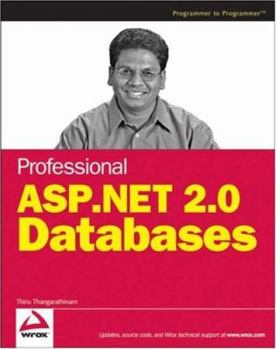Professional ASP.Net 2.0 Databases
Now you can uncover the secrets behind accessing and retrieving data from a wide range of data sources such as SQL Server and XML sources. This book walks you through the array of ADO.NET 2.0 features and clearly shows you how they can be used to develop database-driven web applications in ASP.NET. You'll first gain an in-depth understanding of the data source controls that enable data binding in the ASP.NET platform. Next you'll uncover the advanced features of ASP.NET, including site navigation, implementing sorting and paging, and editing data in templates. You'll then focus on designing transactions in ADO.NET 2.0, displaying data, and utilizing SQL Server 2005 XML. Throughout the chapters, you'll find examples and source code (with ASP.NET examples written in C#) that you can integrate into your applications. This will enable you to leverage ADO.NET and ASP.NET features so you can easily create a scalable N-Tier web site. Some of the topics covered include: ASP.NET 2.0 Data Controls Data Binding with the SqlDataSource Control, XML Data, and Objects Selecting, Updating, Deleting Records Programmatically Creating and Adding Controls XSL Transformations with XmlDataSource Control Using Generics with the ObjectDataSource Control ASP.NET 2.0 Site Navigation including Implementing Breadcrumbs and Binding to Other Controls Displaying and Editing Data Using Templates GridView Sorting and Paging Advanced Data Source and Data-Bound Controls including Master/Detail Display, Displaying Images from a Database, and Using Themes with Data Bound Controls Transactions in .NET and Interoperability between System.Transactions and System.EnterpriseServices Advanced ADO.NET for ASP.NET Data Display including DataSet Object, ADO.NET 2.0 DataTable, and Provider-Independent Data Access Code Accessing Data from SQL Server 2005 including CLR in SQL Server 2005, New XML Features in SQL Server 2005, and Working with XML Data-Typed Columns from ADO.NET N-Tier Architecture with ASP.NET 2.0 and SQL Server 2005 Best Practices for Creating ASP.NET Web Sites including Implementation of CLR Stored Procedures and Implementation of Layers
Format:Paperback
Language:English
ISBN:047004179X
ISBN13:9780470041796
Release Date:February 2007
Publisher:Wrox Press
Length:504 Pages
Weight:1.65 lbs.
Dimensions:1.1" x 7.4" x 9.2"
Customer Reviews
1 rating
Great ASP.NET 2.0 book for Real Developers
Published by Thriftbooks.com User , 17 years ago
There are many ASP.NET 2.0 books on the market now, but they either come in two categories: The beginner who knows another server-side technology (ASP or PHP or even Java) or the advanced who wants to knows about web services or XML implementations or advanced web architecture. I have not found a book that is a solid intermediate ASP.NET 2.0 book on teaching the reader solid, real-life database applications, until now. This book fills in the gaps of so many other books out there on ASP.NET that it really should be the 2nd ASP.NET book you get. If you're already familiar with ASP.NET then this should be your first book. Because pretty much after you know how to use the basic controls and create some master pages and maybe some web parts you really know as much as the majority of the basic ASP.NET developer. This book by Thiru Thangarathinam really gives you a great understanding of "real-world" implementations of ASP.NET applications using any type of database. Like any book, there always will be an introduction on the technology taught, so basically the first three chapters caters to refresh the reader on this technology. Chapter 1 introduces the ASP.NET 2.0 technology and terminology, the new data controls, how master pages work, and web parts framework. Chapter 2 is a very important chapter because it sets the stage for later chapters focusing on ADO.NET. You do not know how many books I have gone through trying to find a book with anything more than 20 pages on ADO.NET. It amazes me that no book (other than this one), really takes the time and explains this corroborating technology in detail when talking about ASP.NET. Yes, I have seen the pure ADO.NET books out there, but they put most of the explanation towards Windows forms, not web forms. I like how the author organizes the material and then further gives greater detail in other chapters (13 and 14). Chapter 3 introduces the reader to the updated data controls with some good detail on the advantages and disadvantages of using them, the new ObjectDataSource control, and how to incorporate the usual data-bound controls (GridView, DetailView and FormView) to them. A very good introduction to the basics. The book (Chapter 4) then goes into using the SqlDataSource control (a good 35 pages) with topics like: Executing stored procedures and returning data, How to process return values from a stored procedure, How to handle null values, How to handle exceptions raised by the SqlDataSource control, How to detect conflict during updates, etc. Not to be overly praising this book, but I cannot remember one book that covered all these interesting topics before. Maybe I've seen this in two or three but not just one. A great chapter. The following chapter (5), the author reviews how to data bind XML data using the XmlDataSourceControl, how to filter the data, applying XSLT stylesheets, programmatically creating a XmlDataSource control, etc. A very thorough explanation of a control that is not talk





